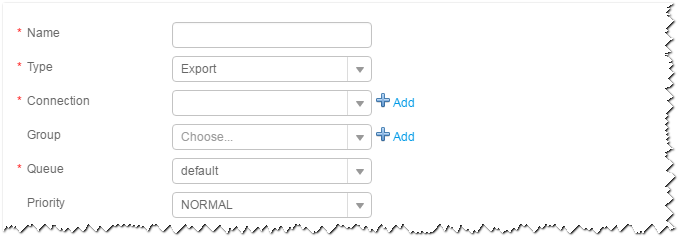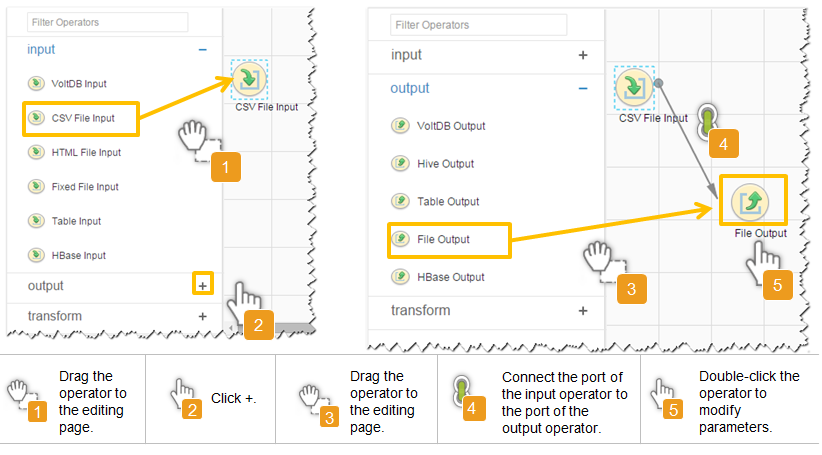Using Loader to Export Data from Hive to an SFTP Server
Scenario
Use Loader to export data from Hive to an SFTP server.
Prerequisites
- You have obtained the service username and password for creating a Loader job.
- You have had the permission to access the Hive table specified in the job.
- You have obtained the username and password of the SFTP server and the user has the write permission of the data export directory on the SFTP server.
- No disk space alarm is reported, and the available disk space is sufficient for importing and exporting data.
- If a configured task requires the Yarn queue function, the user must be authorized with related Yarn queue permission.
- The user who configures a task must obtain execution permission on the task and obtain usage permission on the related connection of the task.
Procedure
Setting Basic Job Information
- Access the Loader web UI.
- Log in to FusionInsight Manager. For details, see Accessing FusionInsight Manager.
- Choose Cluster > Services > Loader.
- Click LoaderServer(Node name, Active). The Loader web UI is displayed.
Figure 1 Loader web UI

- Click New Job to go to the Basic Information page and set basic job information.
Figure 2 Basic Information

- Set Name to the name of the job.
- Set Type to Export.
- Set Group to the group to which the job belongs. No group is created by default. You need to click Add to create a group and click OK to save the created group.
- Set Queue to the Yarn queue that executes the job. The default value is root.default.
- Set Priority to the priority of the Yarn queue that executes the job. The default value is NORMAL. The options are VERY_LOW, LOW, NORMAL, HIGH, and VERY_HIGH.
- In the Connection area, click Add to create a connection, set Connector to sftp-connector, click Add, set connection parameters, and click Test to verify whether the connection is available. When "Test Success" is displayed, click OK. Loader allows multiple SFTP servers to be configured. Click Add to add the configuration information of multiple SFTP servers.
Table 1 Connection parameters Parameter
Description
Example Value
Name
Specifies the name of the SFTP server connection.
sftpName
SFTP server IP
Specifies the IP address of the SFTP server.
10.16.0.1
SFTP server port
Specifies the port number of the SFTP server.
22
SFTP username
Specifies the user name for accessing the SFTP server.
root
SFTP password
Specifies the password for accessing the SFTP server.
xxxx
SFTP public key
Specifies public key of the SFTP server.
OdDt/yn...etM

When multiple SFTP servers are configured, the data of Hive tables will be divided into multiple parts and saved to the SFTP servers randomly.
Setting Data Source Information
- Click Next. On the displayed From page, set Source type to HIVE.
Table 2 Data source parameters Parameter
Description
Example Value
Hive instance
Specifies the Hive service instance that Loader selects from all available Hive service instances in the cluster. If the selected Hive service instance is not added to the cluster, the Hive job cannot run properly.
hive
Quantity
Specifies the number of maps that are started at the same time in a MapReduce job of a data configuration operation. The value must be less than or equal to 3000. You are advised to set the parameter to the maximum number of connections on the SFTP server.
20
Setting Data Transformation
- Click Next. On the displayed Transform page, set the transformation operations in the data transformation process. For details about how to select operators and set parameters, see Loader Operator Help and Table 3.
Table 3 Setting the input and output parameters of the operator Input Type
Export Type
Hive input
File output
Figure 3 Operator operation procedure
Setting Data Storage Information and Executing the Job
- Click Next. On the displayed To page, set the data storage mode.
Table 4 Parameter description Parameter
Description
Example Value
Output path
Specifies the path or file name of the exported file on an SFTP server. If multiple SFTP server IP addresses are configured for the connector, you can set this parameter to multiple paths or file names separated with semicolons (;). Ensure that the number of paths or file names is the same as the number of SFTP servers configured for the connector.
NOTE:You can use macros to define path parameters. For details, see Using Macro Definitions in Configuration Items.
/opt/tempfile
Operation
Specifies the action during data import. When all data is to be imported from the input path to the destination path, the data is stored in a temporary directory and then copied from the temporary directory to the destination path. After the data is imported successfully, the data is deleted from the temporary directory. One of the following actions can be taken when duplicate file names exist during data transfer:
- OVERRIDE: overrides the old file.
- RENAME: renames as new file. For a file without an extension, a string is added to the file name as the extension; for a file with an extension, a string is added to the extension. The string is unique.
- APPEND: adds the content of the new file to the end of the old file. This action only adds content regardless of whether the file can be used. For example, a text file can be used after this operation, while a compressed file cannot.
- IGNORE: reserves the old file and does not copy the new file.
- ERROR: stops the task and reports an error if duplicate file names exist. Transferred files are imported successfully, while files that have duplicate names and files that are not transferred fail to be imported.
OVERRIDE
Encode type
Specifies the exported file encoding format, for example, UTF-8. This parameter can be set only in text file export.
UTF-8
Compression
Indicates whether to enable the compressed transmission function when SFTP is used to import data.
- The value true indicates that compression is enabled.
- The value false indicates that compression is disabled.
true
- Click Save and run to save and run the job.
Checking the Job Execution Result
- Go to the Loader WebUI. When Status is Succeeded, the job is complete.
Figure 4 Viewing a job

Feedback
Was this page helpful?
Provide feedbackThank you very much for your feedback. We will continue working to improve the documentation.






